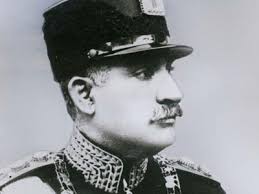I am reading Takeover: The Forgotten History of Hitler’s Establishment Enablers, by Timothy Ryback.
The book is fascinating. It is meticulous in documenting Hitler's rise power. As I read I have the sad ring of familiarity in Hitler's actions: the endless lies, the grievance, the mocking, the scapegoating are all the Trump playbook.
And yet.....
Hitler is 43 years old, has boundless energy, singleness of purpose, and the physical courage of a combat veteran. Trump is flaccid, cowardly, a follower of his base, and nearly all but 80 years old. There is hope.
The inimitable Adam Gopnik reviewed the book. The entire review is below.
--------
Takeover: The Forgotten History of Hitler’s Establishment Enablers
The Nazi leader didn’t seize power; he was given it.
By Adam Gopnik
The media lords thought that they could control him; political schemers thought that they could outwit him. The mainstream left had become a gerontocracy. And all of them failed to recognize his immunity to shame.
Hitler is so fully imagined a subject—so obsessively present on our televisions and in our bookstores—that to reimagine him seems pointless. As with the Hollywood fascination with Charles Manson, speculative curiosity gives retrospective glamour to evil. Hitler created a world in which women were transported with their children for days in closed train cars and then had to watch those children die alongside them, naked, gasping for breath in a gas chamber. To ask whether the man responsible for this was motivated by reading Oswald Spengler or merely by meeting him seems to attribute too much complexity of purpose to him, not to mention posthumous dignity. Yet allowing the specifics of his ascent to be clouded by disdain is not much better than allowing his memory to be ennobled by mystery.
So the historian Timothy W. Ryback’s choice to make his new book, “Takeover: Hitler’s Final Rise to Power” (Knopf), an aggressively specific chronicle of a single year, 1932, seems a wise, even an inspired one. Ryback details, week by week, day by day, and sometimes hour by hour, how a country with a functional, if flawed, democratic machinery handed absolute power over to someone who could never claim a majority in an actual election and whom the entire conservative political class regarded as a chaotic clown with a violent following. Ryback shows how major players thought they could find some ulterior advantage in managing him. Each was sure that, after the passing of a brief storm cloud, so obviously overloaded that it had to expend itself, they would emerge in possession of power. The corporate bosses thought that, if you looked past the strutting and the performative antisemitism, you had someone who would protect your money. Communist ideologues thought that, if you peered deeply enough into the strutting and the performative antisemitism, you could spy the pattern of a popular revolution. The decent right thought that he was too obviously deranged to remain in power long, and the decent left, tempered by earlier fights against different enemies, thought that, if they forcibly stuck to the rule of law, then the law would somehow by itself entrap a lawless leader. In a now familiar paradox, the rational forces stuck to magical thinking, while the irrational ones were more logical, parsing the brute equations of power. And so the storm never passed. In a way, it still has not.
Ryback’s story begins soon after Hitler’s very incomplete victory in the Weimar Republic’s parliamentary elections of July, 1932. Hitler’s party, the National Socialist German Workers’ Party (its German initials were N.S.D.A.P.), emerged with thirty-seven per cent of the vote, and two hundred and thirty out of six hundred and eight seats in the Reichstag, the German parliament—substantially ahead of any of its rivals. In the normal course of events, this would have led the aging warrior Paul von Hindenburg, Germany’s President, to appoint Hitler Chancellor. The equivalent of Prime Minister in other parliamentary systems, the Chancellor was meant to answer to his party, to the Reichstag, and to the President, who appointed him and who could remove him. Yet both Hindenburg and the sitting Chancellor, Franz von Papen, had been firm never-Hitler men, and naïvely entreated Hitler to recognize his own unsuitability for the role.
The N.S.D.A.P. had been in existence since right after the Great War, as one of many völkisch, or populist, groups; its label, by including “national” and “socialist,” was intended to appeal to both right-wing nationalists and left-wing socialists, who were thought to share a common enemy: the élite class of Jewish bankers who, they said, manipulated Germany behind the scenes and had been responsible for the German surrender. The Nazis, as they were called—a put-down made into a popular label, like “Impressionists”—began as one of many fringe and populist antisemitic groups in Germany, including the Thule Society, which was filled with bizarre pre-QAnon conspiracy adepts. Hitler, an Austrian corporal with a toothbrush mustache (when Charlie Chaplin first saw him in newsreels, he assumed Hitler was aping his Little Tramp character), had seized control of the Party in 1921. Then a failed attempt at a putsch in Munich, in 1923, left him in prison, but with many comforts, much respect, and paper and time with which to write his memoir, “Mein Kampf.” He reëmerged as the leader of all the nationalists fighting for election, with an accompanying paramilitary organization, the Sturmabteilung (S.A.), under the direction of the more or less openly homosexual Ernst Röhm, and a press office, under the direction of Joseph Goebbels. (In the American style, the press office recognized the political significance of the era’s new technology and social media, exploiting sound recordings, newsreels, and radio, and even having Hitler campaign by airplane.) Hitler’s plans were deliberately ambiguous, but his purposes were not. Ever since his unsuccessful putsch in Munich, he had, Ryback writes, “been driven by a single ambition: to destroy the political system that he held responsible for the myriad ills plaguing the German people.”
Ryback skips past the underlying mechanics of the July, 1932, election on the way to his real subject—Hitler’s manipulation of the conservative politicians and tycoons who thought that they were manipulating him—but there’s a notable academic literature on what actually happened when Germans voted that summer. The political scientists and historians who study it tell us that the election was a “normal” one, in the sense that the behavior of groups and subgroups proceeded in the usual way, responding more to the perception of political interests than to some convulsions of apocalyptic feeling.
The popular picture of the decline of the Weimar Republic—in which hyperinflation produced mass unemployment, which produced an unstoppable wave of fascism—is far from the truth. The hyperinflation had ended in 1923, and the period right afterward, in the mid-twenties, was, in Germany as elsewhere, golden. The financial crash of 1929 certainly energized the parties of the far left and the far right. Still, the results of the July, 1932, election weren’t obviously catastrophic. The Nazis came out as the largest single party, but both Hitler and Goebbels were bitterly disappointed by their standing. The unemployed actually opposed Hitler and voted en masse for the parties of the left. Hitler won the support of self-employed people, who were in decent economic shape but felt that their lives and livelihoods were threatened; of rural Protestant voters; and of domestic workers (still a sizable group), perhaps because they felt unsafe outside a rigid hierarchy. What was once called the petite bourgeoisie, then, was key to his support—not people feeling the brunt of economic precarity but people feeling the possibility of it. Having nothing to fear but fear itself is having something significant to fear.
It was indeed a “normal” election in that respect, responding not least to the outburst of “normal” politics with which Hitler had littered his program: he had, in the months beforehand, damped down his usual ranting about Jews and bankers and moneyed élites and the rest. He had recorded a widely distributed phonograph album (the era’s equivalent of a podcast) designed to make him seem, well, Chancellor-ish. He emphasized agricultural support and a return to better times, aiming, as Ryback writes, “to bridge divides of class and conscience, socialism and nationalism.” By the strange alchemy of demagoguery, a brief visit to the surface of sanity annulled years and years of crazy.
The Germans were voting, in the absent-minded way of democratic voters everywhere, for easy reassurances, for stability, with classes siding against their historical enemies. They weren’t wild-eyed nationalists voting for a millennial authoritarian regime that would rule forever and restore Germany to glory, and, certainly, they weren’t voting for an apocalyptic nightmare that would leave tens of millions of people dead and the cities of Germany destroyed. They were voting for specific programs that they thought would benefit them, and for a year’s insurance against the people they feared.
Ryback spends most of his time with two pillars of respectable conservative Germany, General Kurt von Schleicher and the right-wing media magnate Alfred Hugenberg. Utterly contemptuous of Hitler as a lazy buffoon—he didn’t wake up until eleven most mornings and spent much of his time watching and talking about movies—the two men still hated the Communists and even the center-left Social Democrats more than they did anyone on the right, and they spent most of 1932 and 1933 scheming to use Hitler as a stalking horse for their own ambitions.
Schleicher is perhaps first among Ryback’s too-clever-for-their-own-good villains, and the book presents a piercingly novelistic picture of him. Though in some ways a classic Prussian militarist, Schleicher, like so many of the German upper classes, was also a cultivated and cosmopolitan bon vivant, whom the well-connected journalist and diarist Bella Fromm called “a man of almost irresistible charm.” He was a character out of a Jean Renoir film, the regretful Junker caught in modern times. He had no illusions about Hitler (“What am I to do with that psychopath?” he said after hearing about his behavior), but, infinitely ambitious, he thought that Hitler’s call for strongman rule might awaken the German people to the need for a real strongman, i.e., Schleicher. Ryback tells us that Schleicher had a strategy he dubbed the Zähmungsprozess, or “taming process,” which was meant to sideline the radicals of the Nazi Party and bring the movement into mainstream politics. He publicly commended Hitler as a “modest, orderly man who only wants what is best” and who would follow the rule of law. He praised Hitler’s paramilitary troops, too, defending them against press reports of street violence. In fact, as Ryback explains, the game plan was to have the Brown Shirts crush the forces of the left—and then to have the regular German Army crush the Brown Shirts.
Schleicher imagined himself a master manipulator of men and causes. He liked to play with a menagerie of glass animal figurines on his desk, leaving the impression that lesser beings were mere toys to be handled. In June of 1932, he prevailed on Hindenburg to give the Chancellorship to Papen, a weak politician widely viewed as Schleicher’s puppet; Papen, in turn, installed Schleicher as minister of defense. Then they dissolved the Reichstag and held those July elections which, predictably, gave the Nazis a big boost.
Ryback spends many mordant pages tracking Schleicher’s whirling-dervish intrigues, as he tried to realize his fantasy of the Zähmungsprozess. Many of these involved schemes shared with the patriotic and staunchly anti-Nazi General Kurt von Hammerstein-Equord (familiar to viewers of “Babylon Berlin” as Major General Seegers). Hammerstein was one of the few German officers to fully grasp Hitler’s real nature. At a meeting with Hitler in the spring of 1932, Hammerstein told him bluntly, “Herr Hitler, if you achieve power legally, that would be fine with me. If the circumstances are different, I will use arms.” He later felt reassured when Hindenburg intimated that, if the Nazi paramilitary troops acted, he could order the Army to fire on them.
Yet Hammerstein remained impotent. At various moments, Schleicher, as the minister of defense, entertained what was in effect a plan for imposing martial law with himself in charge and Hammerstein at his side. In retrospect, it was the last hope of protecting the republic from Hitler—but after President Hindenburg rejected it, not out of democratic misgivings but out of suspicion of Schleicher’s purposes, Hammerstein, an essentially tragic figure, was unable to act alone. He suffered from a malady found among decent military men suddenly thrust into positions of political power: his scruples were at odds with his habits of deference to hierarchy. Generals became generals by learning to take orders before they learned how to give them. Hammerstein hated Hitler, but he waited for someone else of impeccable authority to give a clear direction before he would act. (He went on waiting right through the war, as part of the equally impotent military nexus that wanted Hitler dead but, until it was too late, lacked the will to kill him.)
The extra-parliamentary actions that were fleetingly contemplated in the months after the election—a war in the streets, or, more likely, a civil confrontation leading to a military coup—seemed horrific. The trouble, unknowable to the people of the time, is that, since what did happen is the worst thing that has ever happened, any alternative would have been less horrific. One wants to shout to Hammerstein and his cohorts, Go ahead, take over the government! Arrest Hitler and his henchmen, rule for a few years, and then try again. It won’t be as bad as what happens next. But, of course, they cannot hear us. They couldn’t have heard us then.
Ryback’s gift for detail joins with a nice feeling for the black comedy of the period. He makes much sport of the attempts by foreign journalists resident in Germany, particularly the New York Times’ Frederick T. Birchall, to normalize the Nazi ascent—with Birchall continually assuring his readers that Hitler, an out-of-his-depth simpleton, was not the threat he seemed to be, and that the other conservatives were far more potent in their political maneuvering. When Papen made a speech denying that Hitler’s paramilitary forces represented “the German nation,” Birchall wrote that the speech “contained dynamite enough to change completely the political situation in the Reich.” On another occasion, Birchall wrote that “the Hitlerites” were deluded to think they “hold the best cards”; there was every reason to think that “the big cards, the ones that will really decide the game,” were in the hands of people such as Papen, Hindenburg, and, “above all,” Schleicher.
Ryback, focussing on the self-entrapped German conservatives, generally avoids the question that seems most obvious to a contemporary reader: Why was a coalition between the moderate-left Social Democrats and the conservative but far from Nazified Catholic Centrists never even seriously attempted? Given that Hitler had repeatedly vowed to use the democratic process in order to destroy democracy, why did the people committed to democracy let him do it?
Many historians have jousted with this question, but perhaps the most piercing account remains an early one, written less than a decade after the war by the émigré German scholar Lewis Edinger, who had known the leaders of the Social Democrats well and consulted them directly—the ones who had survived, that is—for his study. His conclusion was that they simply “trusted that constitutional processes and the return of reason and fair play would assure the survival of the Weimar Republic and its chief supporters.” The Social Democratic leadership had become a gerontocracy, out of touch with the generational changes beneath them. The top Social Democratic leaders were, on average, two decades older than their Nazi counterparts.
Worse, the Social Democrats remained in the grip of a long struggle with Bismarckian nationalism, which, however oppressive it might have been, still operated with a broad idea of legitimacy and the rule of law. The institutional procedures of parliamentarianism had always seen the Social Democrats through—why would those procedures not continue to protect them? In a battle between demagoguery and democracy, surely democracy had the advantage. Edinger writes that Karl Kautsky, among the most eminent of the Party’s theorists, believed that after the election Hitler’s supporters would realize he was incapable of fulfilling his promises and drift away.
The Social Democrats may have been hobbled, too, by their commitment to team leadership—which meant that no single charismatic individual represented them. Proceduralists and institutionalists by temperament and training, they were, as Edinger demonstrates, unable to imagine the nature of their adversary. They acceded to Hitler’s ascent with the belief that by respecting the rules themselves they would encourage the other side to play by them as well. Even after Hitler consolidated his power, he was seen to have secured the Chancellorship by constitutional means. Edinger quotes Arnold Brecht, a fellow exiled statesman: “To rise against him on the first night would make the rebels the technical violators of the Constitution that they wanted to defend.”
Meanwhile, the centrist Catholics—whom Hitler shrewdly recognized as his most formidable potential adversaries—were handicapped in any desire to join with the Democratic Socialists by their fear of the Communists. Though the Communists had previously made various alliances of convenience with the Social Democrats, by 1932 they were tightly controlled by Stalin, who had ordered them to depict the Social Democrats as being as great a threat to the working class as Hitler.
And, when a rumor spread that Hitler had once spat out a Communion Host, it only made him more popular among Catholics, since it called attention to his Catholic upbringing. Indeed, most attempts to highlight Hitler’s personal depravities (including his possibly sexual relationship with his niece Geli, which was no secret in the press of the time; her apparent suicide, less than a year before the election, had been a tabloid scandal) made him more popular. In any case, Hitler was skilled at reassuring the Catholic center, promising to be “the strong protector of Christianity as the basis of our common moral order.”
Hitler’s hatred of parliamentary democracy, even more than his hatred of Jews, was central to his identity, Ryback emphasizes. Antisemitism was a regular feature of populist politics in the region: Hitler had learned much of it in his youth from the Vienna mayor Karl Lueger. But Lueger was a genuine populist democrat, who brought universal male suffrage to the city. Hitler’s originality lay elsewhere. “Unlike Hitler’s anti-Semitism, a toxic brew of pseudoscientific readings and malignant mentoring, Hitler’s hatred of the Weimar Republic was the result of personal observation of political processes,” Ryback writes. “He hated the haggling and compromise of coalition politics inherent in multiparty political systems.”
Second only to Schleicher in Ryback’s accounting of Hitler’s establishment enablers is the media magnate Alfred Hugenberg. The owner of the country’s leading film studio and of the national news service, which supplied some sixteen hundred newspapers, he was far from an admirer. He regarded Hitler as manic and unreliable but found him essential for the furtherance of their common program, and was in and out of political alliance with him during the crucial year.
Hugenberg had begun constructing his media empire in the late nineteen-teens, in response to what he saw as the bias against conservatives in much of the German press, and he shared Hitler’s hatred of democracy and of the Jews. But he thought of himself as a much more sophisticated player, and intended to use his control of modern media in pursuit of what he called a Katastrophenpolitik—a “catastrophe politics” of cultural warfare, in which the strategy, Ryback says, was to “flood the public space with inflammatory news stories, half-truths, rumors, and outright lies.” The aim was to polarize the public, and to crater anything like consensus. Hugenberg gave Hitler money as well as publicity, but Hugenberg had his own political ambitions (somewhat undermined by a personal aura described by his nickname, der Hamster) and his own party, and Hitler was furiously jealous of the spotlight. While giving Hitler support in his media—a support sometimes interrupted by impatience—Hugenberg urged him to act rationally and settle for Nazi positions in the cabinet if he could not have the Chancellorship.
What strengthened the Nazis throughout the conspiratorial maneuverings of the period was certainly not any great display of discipline. The Nazi movement was a chaotic mess of struggling in-groups who feared and despised one another. Hitler rightly mistrusted the loyalty even of his chief lieutenant, Gregor Strasser, who fell on the “socialist” side of the National Socialists label. The members of the S.A., the Storm Troopers, meanwhile, were loyal mainly to their own leader, Ernst Röhm, and embarrassed Hitler with their run of sexual scandals. The N.S.D.A.P. was a hive of internal antipathies that could resolve only in violence—a condition that would endure to the last weeks of the war, when, standing amid the ruins of Germany, Hitler was enraged to discover that Heinrich Himmler was trying to negotiate a separate peace with the Western Allies.
The strength of the Nazis lay, rather, in the curiously enclosed and benumbed character of their leader. Hitler was impossible to discourage, not because he ran an efficient machine but because he was immune to the normal human impediments to absolute power: shame, calculation, or even a desire to see a particular political program put in place. Hindenburg, knowing of Hitler’s genuinely courageous military service in the Great War, appealed in their meetings to his patriotism, his love of the Fatherland. But Hitler, an Austrian who did not receive German citizenship until shortly before the 1932 election, did not love the Fatherland. He ran on the hydrogen fuel of pure hatred. He did not want power in order to implement a program; he wanted power in order to realize his pain. A fascinating and once classified document, prepared for the precursor of the C.I.A., the O.S.S., by the psychoanalyst Walter Langer, used first-person accounts to gauge the scale of Hitler’s narcissism: “It may be of interest to note at this time that of all the titles that Hitler might have chosen for himself he is content with the simple one of ‘Fuehrer.’ To him this title is the greatest of them all. He has spent his life searching for a person worthy of the role but was unable to find one until he discovered himself.” Or, as the acute Hungarian American historian John Lukacs, who spent a lifetime studying Hitler’s psychology, observed, “His hatred for his opponents was both stronger and less abstract than was his love for his people. That was (and remains) a distinguishing mark of the mind of every extreme nationalist.”
In November of 1932, one more Reichstag election was held. Once again, it was a bitter disappointment to Hitler and Goebbels—“a disaster,” as Goebbels declared on Election Night. (An earlier Presidential election had also reaffirmed Hindenburg over the Hitler movement.) The Nazi wave that everyone had expected failed to materialize. The Nazis lost seats, and, once again, they could not crack fifty per cent. The Times explained that the Hitler movement had passed its high-water mark, and that “the country is getting tired of the Nazis.” Everywhere, Ryback says, the cartoonists and editorialists delighted in Hitler’s discomfiture. One cartoonist showed him presiding over a graveyard of swastikas. In December of 1932, having lost three elections in a row, Hitler seemed to be finished.
The subsequent maneuverings are as dispiriting to read about as they are exhausting to follow. Basically, Schleicher conspired to have Papen fired as Chancellor by Hindenburg and replaced by himself. He calculated that he could cleave Gregor Strasser and the more respectable elements of the Nazis from Hitler, form a coalition with them, and leave Hitler on the outside looking in. But Papen, a small man in everything except his taste for revenge, turned on Schleicher in a rage and went directly to Hitler, proposing, despite his earlier never-Hitler views, that they form their own coalition. Schleicher’s plan to spirit Strasser away from Hitler and break the Nazi Party in two then stumbled on the reality that the real base of the Party was fanatically loyal only to its leader—and Strasser, knowing this, refused to leave the Party, even as he conspired with Schleicher to undermine it.
Then, in mid-January, a small regional election in Lipperland took place. Though the results were again disappointing for Hitler and Goebbels—the National Socialist German Workers’ Party still hadn’t surmounted the fifty-per-cent mark—they managed to sell the election as a kind of triumph. At Party meetings, Hitler denounced Strasser. The idea, much beloved by Schleicher and his allies, of breaking a Strasser wing of the Party off from Hitler became obviously impossible.
Hindenburg, in his mid-eighties and growing weak, became fed up with Schleicher’s Machiavellian stratagems and dispensed with him as Chancellor. Papen, dismissed not long before, was received by the President. He promised that he could form a working majority in the Reichstag by simple means: Hindenburg should go ahead and appoint Hitler Chancellor. Hitler, he explained, had made significant “concessions,” and could be controlled. He would want only the Chancellorship, and not more seats in the cabinet. What could go wrong? “You mean to tell me I have the unpleasant task of appointing this Hitler as the next Chancellor?” Hindenburg reportedly asked. He did. The conservative strategists celebrated their victory. “So, we box Hitler in,” Hugenberg said confidently. Papen crowed, “Within two months, we will have pressed Hitler into a corner so tight that he’ll squeak!”
“The big joke on democracy is that it gives its mortal enemies the tools to its own destruction,” Goebbels said as the Nazis rose to power—one of those quotes that sound apocryphal but are not. The ultimate fates of Ryback’s players are varied, and instructive. Schleicher, the conservative who saw right through Hitler’s weakness—who had found a way to entrap him, and then use him against the left—was killed by the S.A. during the Night of the Long Knives, in 1934, when Hitler consolidated his hold over his own movement by murdering his less loyal lieutenants. Strasser and Röhm were murdered then, too. Hitler and Goebbels, of course, died by their own hands in defeat, having left tens of millions of Europeans dead and their country in ruins. But Hugenberg, sidelined during the Third Reich, was exonerated by a denazification court in the years after the war. And Papen, who had ushered Hitler directly into power, was acquitted at Nuremberg; in the nineteen-fifties, he was awarded the highest honorary order of the Catholic Church.
Does history have patterns or merely circumstances and unique contingencies? Certainly, the Germany of 1932 was a place unto itself. The truth, that some cycles may recur but inexactly, is best captured in that fine aphorism “History does not repeat itself, but it sometimes rhymes.” Appropriately, no historian is exactly sure who said this: widely credited to Mark Twain, it was more likely first said long after his death.
We see through a glass darkly, as patterns of authoritarian ambition seem to flash before our eyes: the demagogue made strong not by conviction but by being numb to normal human encouragements and admonitions; the aging center left; the media lords who want something like what the demagogue wants but in the end are controlled by him; the political maneuverers who think they can outwit the demagogue; the resistance and sudden surrender. Democracy doesn’t die in darkness. It dies in bright midafternoon light, where politicians fall back on familiarities and make faint offers to authoritarians and say a firm and final no—and then wake up a few days later and say, Well, maybe this time, it might all work out, and look at the other side! Precise circumstances never repeat, yet shapes and patterns so often recur. In history, it’s true, the same thing never happens twice. But the same things do.
































